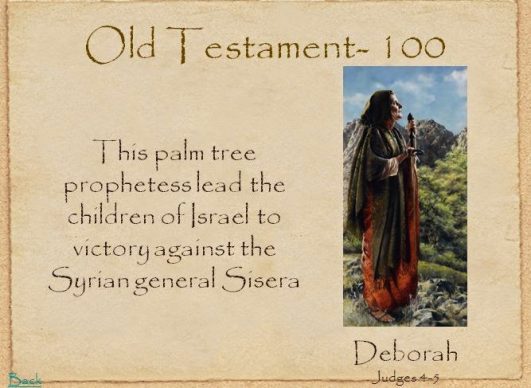How well do the women of your Relief Society know the women of the scriptures? One ward in Sandy, Utah recently found out during a Women of the Scriptures Jeopardy! night. Apparently the evening’s game was pulled from a site I’ve admired for quite some time, Women in the Scriptures, run by the self-taught scriptural scholar Heather Farrell. (We interviewed Heather a few years ago for the MWP and you can find the interview here. In addition, Heather has been a contributor to our Sunday School Supplements and a participant in one of our fundraising Salons some years ago.)
Heather has created a downloadable presentation that is a ready-to-go kit for a fun family or Relief Society activity. My mother-in-law attended the Sandy, Utah event, and I found her description of the reactions interesting: It sounds like the women participating were surprised at how poorly they fared in the game and expressed feeling guilty they didn’t know these women better.
While I think a dose of guilt about not knowing the women in the scriptures can be a healthy thing, I also think we shouldn’t be too hard on ourselves. After all, there is very little built into the programs of the Church currently (i.e. Seminary and Institute curriculums, Sunday School manuals) to institutionally and proactively draw attention to the women in the scriptures. And proactivity is what is needed to notice the women in the scriptures, since most of the women – aside from the key ones like Mary, Sariah and Eve – are, as Heather says, “hidden within the pages of the scriptures.” Heather and other biblical scholars have found literally hundreds of women in the scriptures, most of whom are unnamed or referred to in groups. To find them, a student of the scriptures must read with a particular eye to noticing them and honoring them with extra attention. That is not something we in the Church – even women in the Church – have dedicated ourselves to with any uniformity or proactivity within the past generations.
But two things are changing. First, there is a rising awareness that there is a whole half of the population whose voices are silent as we read the spiritual histories of ancient civilizations. I appreciated, for instance, when my own Sunday School teacher a few weeks ago noted to the class that women’s voices are practically non-existent in the Book of Mormon. A few minutes later the whole class had a good laugh when the teacher revealed that Jarom or Omni (I can’t remember which) was over 70 years old when his son was born, and I said, “Now there was a woman in there who’s story I’d like to hear about!” Simple conversations like this within our institutional meetings help us recognize communally how women might feel absent from the scriptures.
Secondly, we have more and more resources at our fingertips that will help us notice, study and revere the women of the scriptures. In addition to Heather’s good work, there are our Sunday School Supplements, BYU professor Camille Fronk Olsen’s beautiful books Women of the New Testament and Women of the Old Testament, the Girls Who Choose God series, and a few other Deseret Book resources. The larger Christian tradition actually has a whole genre dedicated to studying women of the Bible, dominated mostly by Liz Curtis Higgs and her Bad Girls of the Bible books and workbooks. These are delightful, witty (and suppositional) explorations into some of the femmes fatals we love to hate. (She also excels in historical novels about biblical women and explores the not-so-bad girls of the Bible too, fortunately making it clear that not all women in the scriptures are “vamps or tramps”.)
Have you ever made searching for the women of the scriptures part of your scripture study? What did you discover? What other resources were helpful to you?

